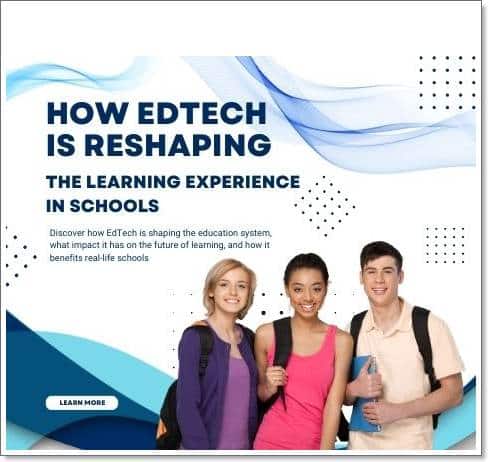
Education is constantly evolving, and the rapid growth of educational technology (EdTech) has played a significant role in reshaping the learning experience in schools. By integrating technology into the classroom, educators can create more interactive, engaging, and personalized educational experiences for students. In this article, we will explore the various ways EdTech is transforming the learning landscape in schools and how it can continue to enhance education in the future.
1.Personalized Learning
One of the key ways EdTech is reshaping the learning experience is by enabling personalized learning. With the help of technology, teachers can create customized lesson plans that cater to each student’s unique strengths, weaknesses, and learning styles. This approach allows for more individualized attention and targeted instruction, which can lead to improved academic performance and increased student engagement.
2.Enhanced Student Collaboration
The integration of EdTech in the classroom has also paved the way for greater student collaboration. Through the use of collaborative platforms and tools, students can work together on projects, share ideas, and provide feedback in real-time, regardless of their physical location. This connected learning environment fosters teamwork, communication, and problem-solving skills, preparing students for success in the workforce.
3.Interactive and Engaging Learning Experiences
EdTech provides a variety of interactive tools and resources that make learning more engaging and enjoyable for students. From gamification elements and virtual reality simulations to interactive whiteboards and multimedia presentations, technology helps bring learning to life and encourages active participation from students.
4.Incorporating 3D Printers for Classrooms
The use of 3D printers for classrooms is another exciting development in the world of EdTech. By integrating 3D printing technology into the curriculum, students can gain hands-on experience with design, engineering, and problem-solving. This cutting-edge technology not only enhances students’ creativity but also provides valuable exposure to advanced manufacturing techniques that are increasingly in demand in various industries.
5.Increased Accessibility and Inclusivity
EdTech can play a vital role in increasing accessibility and inclusivity in the classroom. Assistive technologies, such as text-to-speech tools, closed captioning, and alternative input devices, can help students with disabilities overcome barriers and participate fully in the learning process. Additionally, EdTech can support multilingual learners by offering translation tools and resources in various languages.
6.Improved Assessment and Feedback
The integration of technology in education has led to the development of sophisticated assessment and feedback tools. These tools provide teachers with real-time data on student performance, helping them identify areas of improvement and modify instruction accordingly. Moreover, EdTech platforms often incorporate instant feedback mechanisms, allowing students to understand their mistakes and make necessary adjustments more quickly.
7.Access to a Wealth of Educational Resources
EdTech has democratized access to a wide range of educational resources, including digital textbooks, online courses, and interactive learning modules. These resources offer students the opportunity to explore subjects beyond the confines of their classroom and can supplement traditional instruction, resulting in a more well-rounded education.
8.Encouraging Lifelong Learning
By exposing students to technology in the classroom, educators can foster a love for lifelong learning and encourage students to take charge of their education. EdTech platforms and tools often incorporate elements of self-directed learning, allowing students to set their own goals, explore their interests, and develop valuable skills for the future.
9.Promoting Critical Thinking and Problem-Solving Skills
EdTech tools and resources can help students develop critical thinking and problem-solving skills by presenting them with complex, real-world challenges. Through the use of technology, students can explore diverse perspectives, analyze data, and engage in simulations that require creative solutions. These experiences not only promote deeper learning but also equip students with essential skills that will serve them well in their future careers.
10.Fostering Digital Citizenship
Integrating EdTech into the classroom offers the perfect opportunity to teach students about digital citizenship and responsible technology use. Educators can guide students in understanding the importance of online privacy, cyberbullying prevention, and the ethical use of digital resources. By instilling these values, schools can create responsible digital citizens who are prepared to navigate the increasingly connected world.
In conclusion, the rapid growth of EdTech has significantly reshaped the learning experience in schools, resulting in more personalized, engaging, and accessible education for students. By continuing to invest in and embrace these technological advancements, educators can create dynamic learning environments that empower students to reach their full potential and prepare them for the challenges of the 21st century.
Leave a Reply
You must be logged in to post a comment.